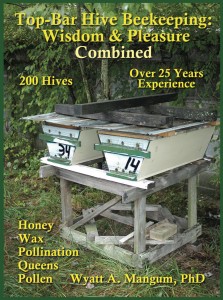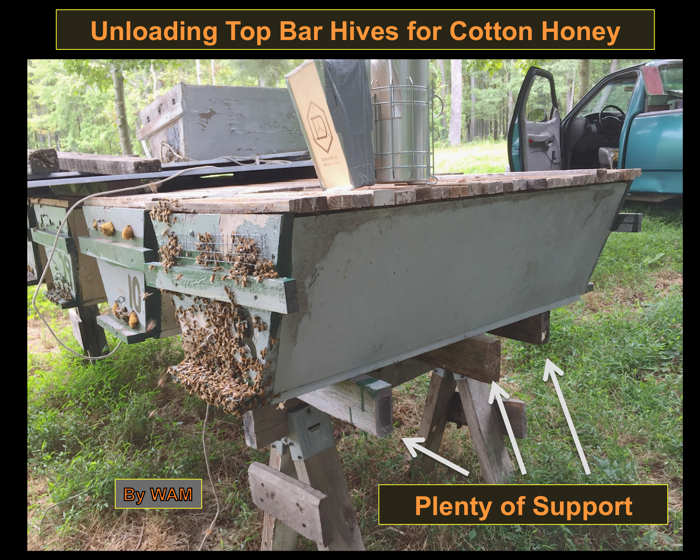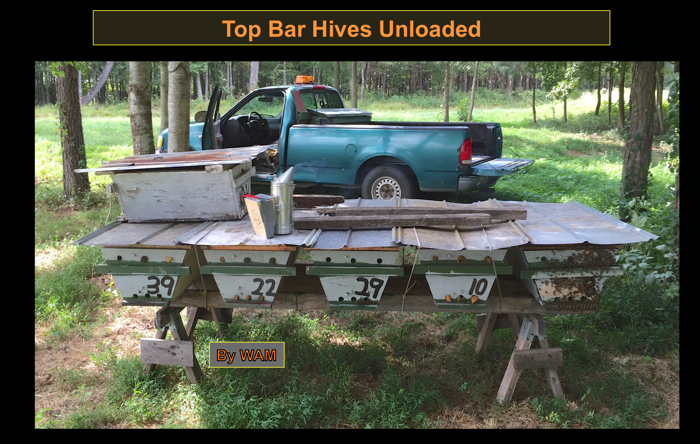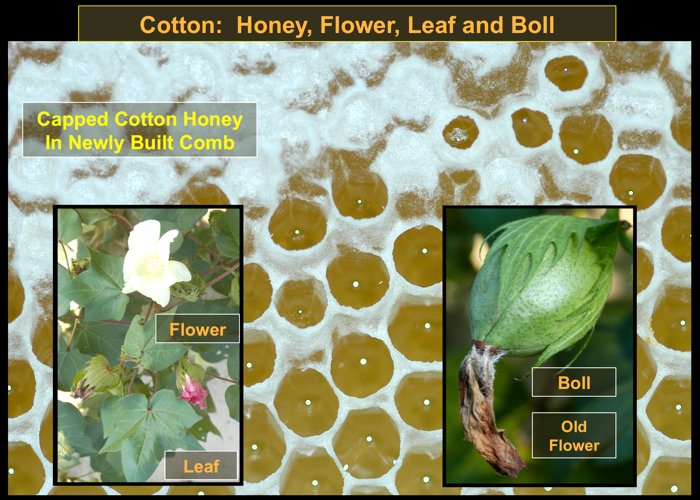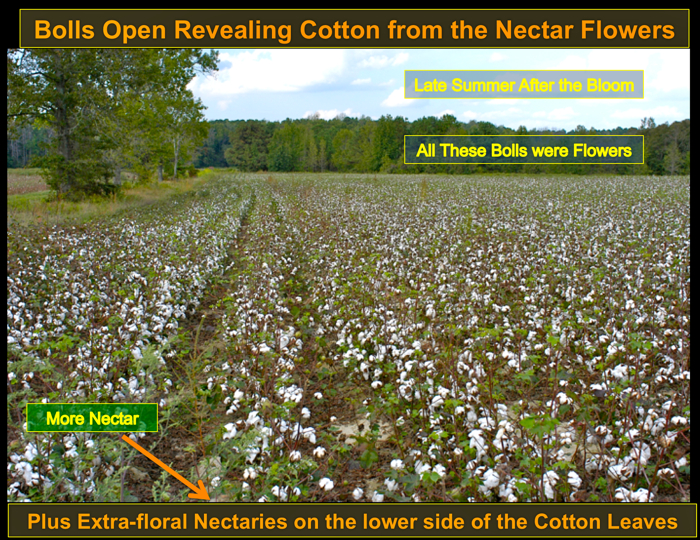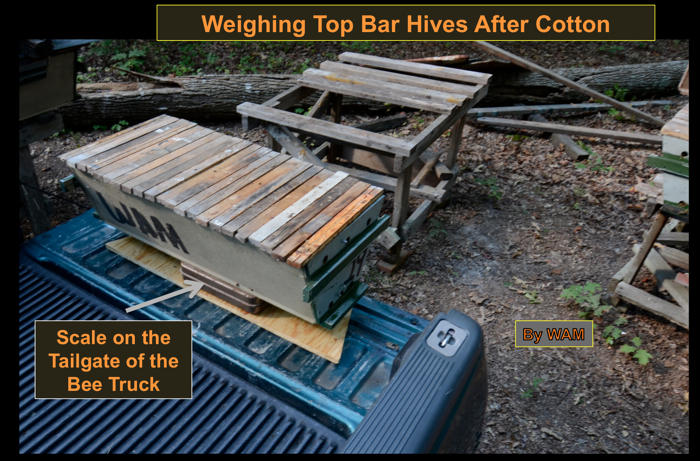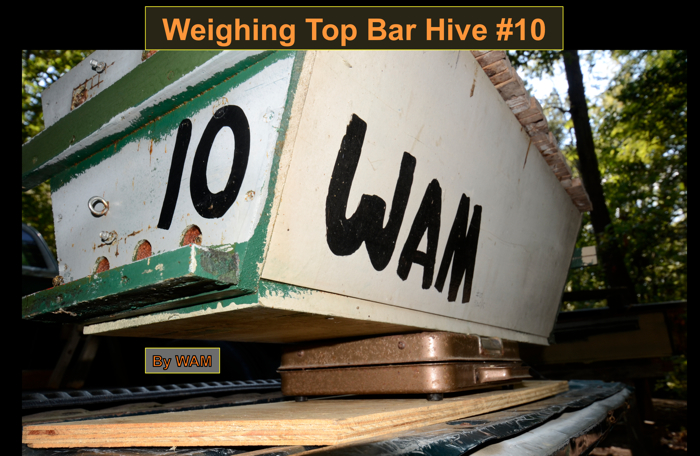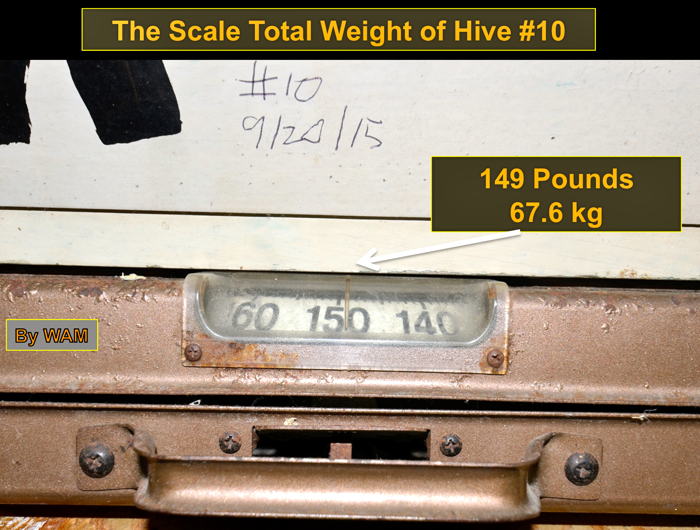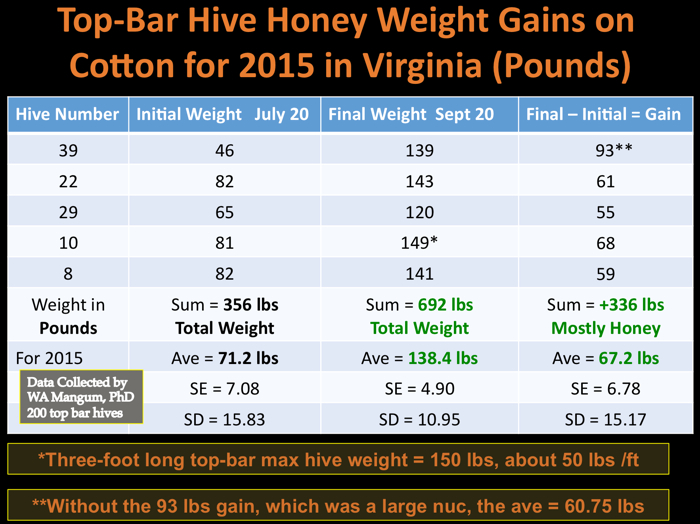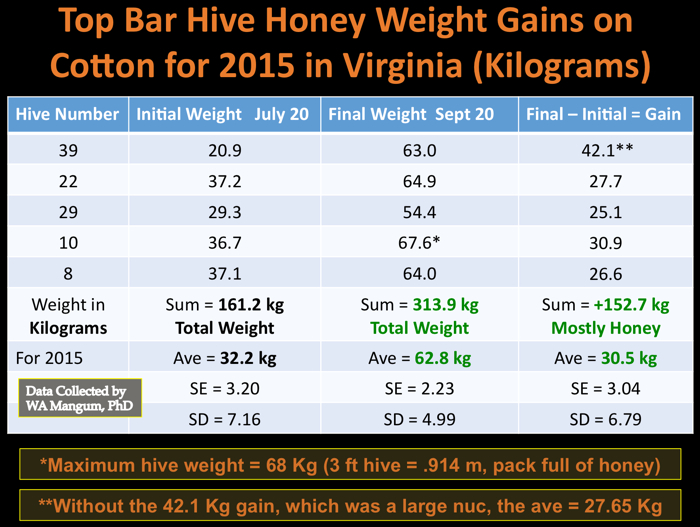Honey Production from Top Bar Hives
Top Bar Hives Produce Plenty of Honey
Summary. This page shows cotton honey production from top bar hives for two years. In 2015 after the Spring build up, new first-season colonies gained an extra 61 lbs (27.7 kg), on average, of mostly cotton honey in the summer. In 2016 established top bar colonies produced about the same, 62 lbs (28.1 kg), on average. However, if the top bar hive was empty enough (had plenty of storage room), some colonies gained 80 – 90 lbs (36.3 – 40.8 kgs), provided the colony was ready for honey production. (For the biology of cotton producing nectar and making white bolls of lint, look under 2015.)
The general bee management details for honey production are in my top bar hive beekeeping book.
Each year has its details under its heading running from newest to oldest: 2016, 2015.

Top Bar Hive Honey Production for 2016
In the Spring of 2016, a long, cold, rainy period occurred in our main nectar flow. With the Spring nectar flow demolished, my bees needed Summer cotton honey more than I had planned. Below is a summary the 2016 cotton honey season.
For more details, see the February 2017 issue of Bee Culture, the article titled, “Honey by the Ton with Top Bar Hives.”
I transported 14 three-foot hives, mostly the lighter weight hives, in several trips beginning around July 20, 2016. (I also moved five-foot long hives and two-foot long top bar hives in those loads, but the 2016 data are for three-foot long hives.) Below is the apiary for 2016 with the hives in a “U” pattern, and the bee truck parked in the middle.
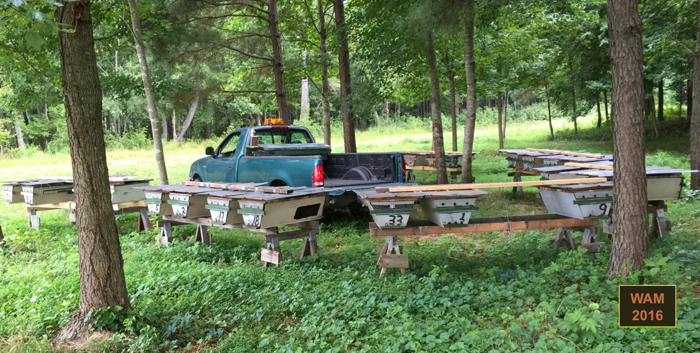
The next picture shows how I collected the data on the hive weights. The procedure was similar to that done in 2015, weighing the hives on the tailgate of the truck. Hives are easy to load, but hard to weigh because they need to be lifted and placed on the scale under the middle of the hive.
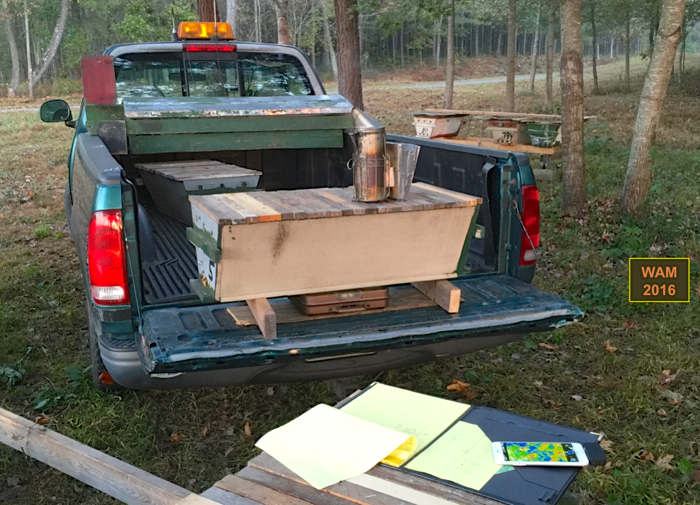
The 2016 Honey Weight Gain Table has the same layout as the 2015 Table further down the page under the 2015 heading. The first table is in Pounds and the second table is in Kilograms. Most of the hive weight GAINS were from cotton honey (the last column as in 2015).
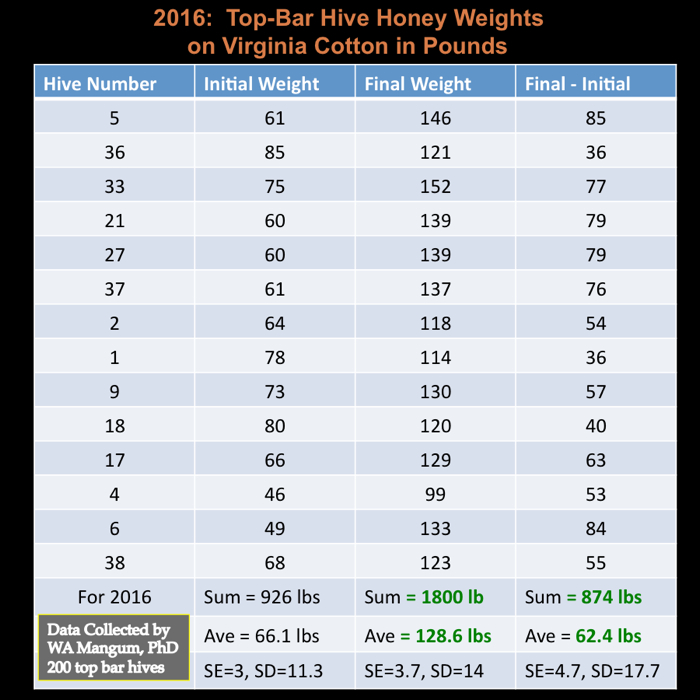
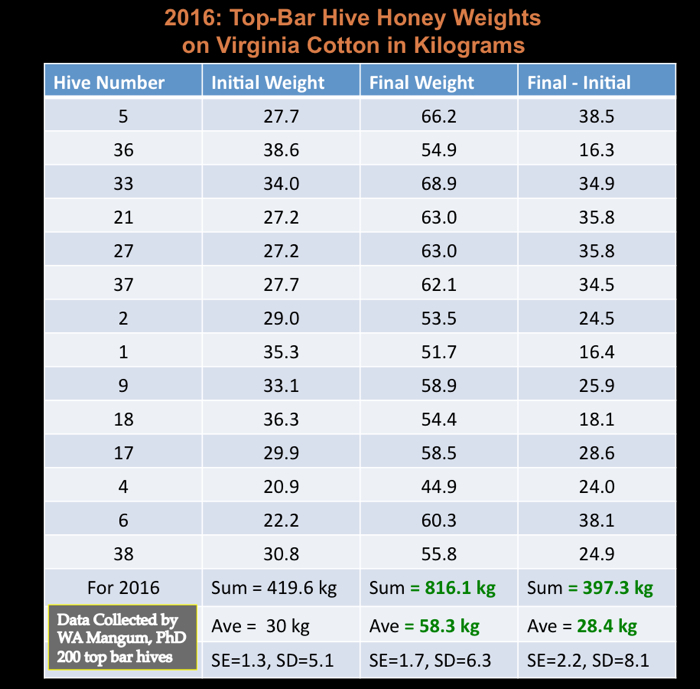
Notice Hive 6, its initial weight of 49 pounds (22.2 kg), had a sizable gain of 84 pounds (38.1 kg), something like Hive 39 (in 2015), which weighed 46 pounds (20.9 kg), and gained 93 pounds (42.2 kg). Notice in both cases relatively empty hives had room for big weight gains. On the other hand, Hive 5, initially heavier at 61 pounds (27.7 kg), gained 85 pounds (38.6 kg).
Going out in July, the 14 hives weighed 926 pounds total (429.0 kg) and their average initial hive weight was 66.1 pounds (30.0 kg). When I hauled the hives home in October, together they weighed 1800 pounds (816.5 kg), almost a ton (2000 pounds, 907.2 kg). Over the cotton bloom, the hive weight almost doubled (1800/926 = 1.94, almost 2), increasing by the same factor (1.94) as the previous year (2015). The average weight of the returning hives was 128.6 pounds (58.3 kg).
By inspection, the 2016 average weight gain of 62.4 pounds (28.3 kg) seemed similar to the gain observed in 2015 of 60.75 pounds (27.6 kg). Rounded to the nearest pound, the result is 61 versus 62 pounds for 2015 and 2016 respectively (27.7 versus 28.1 kg).
Therefore, currently the expectation seems to be three-foot hives without multiple harvests have a gross weight gain in pounds in the low 60’s pounds (27.2 kg) when the hive is already somewhat full.
Please note: Many of these three-foot long hives were not empty enough to measure their full possible weight gains. For example, a hive initially weighing 80 pounds, cannot gain 93 pounds like Hive 39 did in 2015 because 80+93=173 pounds. That is way over the 150-pound weight limit of a three-foot top-bar hive of my dimensions (about 50 pounds per foot). So the low 60-pound gain estimate is a very conservative estimate, meaning most likely the actual value is much higher, as with Hives 6 and 39 aiming upwards to almost 100 pounds, depending on the condition of the colony.
Another important point: In actual top-bar hive management, the beekeeper should conduct multiple harvests during the flow to obtain more honey. I wanted to weigh the hives intact and only once. When the hive begins to become full, I expect a crowding effect to occur where the bees slow their foraging. It has been known for a long time that a similar crowding effect occurs in colonies before they produce a Spring swarm.
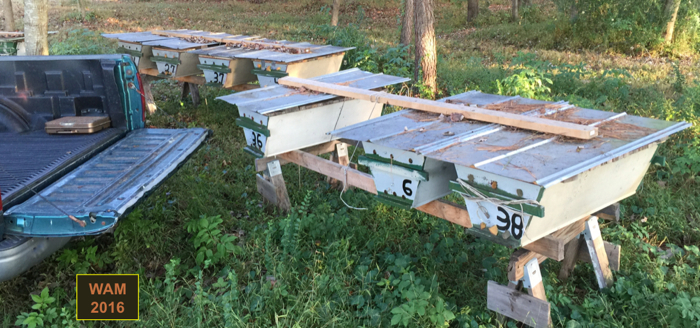
Consider supporting these pages by making a donation. Click the donation button below and enter credit card or debit card information. Paypal handles all the security. Or you can purchase a copy of my book. Clicking the book takes you to a page describing its 12 chapters. Thank you.
W. A. Mangum, PhD
Top Bar Hive Honey Production for 2015
In the Spring of 2015, I caught 17 swarms in my bait hives as described in my top bar hive book. (30% of my bait hives caught swarms.) Normally first-season colonies, like these swarms (or package bee colonies) do not produce surplus honey in their build up year, but they can, and in top bar hives.
I moved five of these hives to Southern Virginia to make cotton honey on July 20, 2015. The plants were already in full bloom. Below are the top bar hives on supports in a shaded location with cotton fields all around (out of view). The hives were three-foot long. With plenty of nectar coming in, these hives can weigh up to a maximum of about 150 lbs (68 kg), assuming no multiple honey harvests (which is the recommended management) so the bees could produce even more honey.
Below I have finished unloading on July 20, 2015. I alternated the entrances to reduce drifting (bees going in the wrong entrance). I cut entrance holes in both ends of my top bar hives and stuff sponges in the rear holes when they are not used. I tied down the metal covers. I weighed the hives when I unloaded them to get their initial weights.
Here is cotton honey along with the cotton plants.
When the bolls open and the cotton splits out, the fields look snowy white. Time to haul back the hives.
I brought the hives back on September 20, 2015, two months later. Then I weighed the hives the next morning after they arrived back at their home apiary. (Because at the cotton location, I loaded the heavy hives in the dark, working alone, and could not weigh them there).
Below is an example, Hive number 10. The hive weight after making summer honey was 149 lbs (67.6 kg) with a gain of 68 lbs (30.9 kg).
Below is the scale reading of Hive number 10, which means I need to gently put the 149 lb hive (67.6 kg) on the flat scale as shown, same as the other hives. As mentioned above, a three-foot long top bar hive with my cross-section size, has a maximum hive weight packed full of honey of about 150 pounds (68 kg). Hive number 10 is about at its maximum weight. I can use its extra honey to feed other colonies.
Below are the honey-weight gain tables for the five hives. The first table is in Pounds; the second table is in Kilograms. Here is a summary of the numbers and what happened.
Most of the weight GAINS were from cotton honey (the last column). A cotton nectar flow is typically slow and is a steady flow, weather permitting. Cotton honey is not considered a table grade honey by itself, but it can be blended with other honeys. I use it to feed bees and to build up colonies.
The average honey weight gain for the five colonies was 67.2 lbs (30.5 kg). The increase in weight for all five hives was 336 lbs (152.7 kg) for a total weight of 692 lbs (313.9 kg). That is, 692 lbs (313.9 kg) was the total hive weight I hauled back, and put on the scale, up from 356 lbs (161.2 kg) for the five hives I set out in the beginning. Over all the total hive weight almost doubled (692/356 = 1.94, almost 2). During that same time in the summer at my home apiaries, hive weights decrease as the bees consume their winter honey prematurely.
Hive 39 was low on honey compared to the other hives (see table below, first row), and it had a huge weight gain of almost 100 pounds. Without Hive 39, the average honey weight gain was about 60 lbs (27.75 kg) for the remaining four hives. That lower average, 60 lbs (27.75 kg) down from 67.2 lbs (30.5 kg), I think is more typical of mature first-season colonies moved to a summer nectar flow. However, Hive 39 showed how a big healthy nuc can build up strong, ready for winter.
Note: Put the pieces together. Below is an example of top bar hive honey production. The “Green top bar hives” in my book and on my web page, show how to construct top bar hives for only a few dollars each, if that. Or one can build the hives from boards still at a reasonable cost. My top bar hive products page show all the other ways top bar hives can generate revenue. But a beekeeper needs to know how to manage the bees, keep them healthy, and many other important things to make beekeeping successful and sustainable. When I was a beekeeper in high school, I had 125 frame hives, and produced honey by the ton. Back then, I had about 40 beekeeping books. And those books saved me a lot of sorrow.
You can support this top bar and honey production work by purchasing a copy of my book. Please do not copy the content of my website as I hold the copyrights. If you want to use the above tables and information by streaming them to your meeting site for a presentation, consider buying a copy of my book as a fair trade. I formally agree to that exchange. Other beekeepers have done that swap, and it worked quite well. I have a very dependable web page host. If you have questions about linking your meeting site to my web page, use the contact email form at the bottom of the book-ordering page. To get to that page quickly, click on the book picture below.
Consider supporting these pages by making a donation. Click the donation button below and enter credit card or debit card information. Paypal handles all the security. Or you can purchase a copy of my book. Clicking the book takes you to a page describing its 12 chapters. Thank you.
W. A. Mangum, PhD
